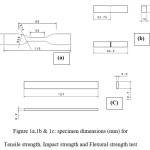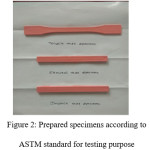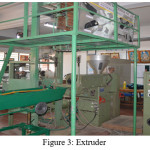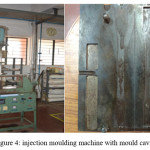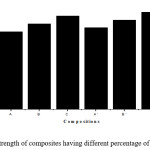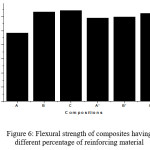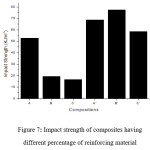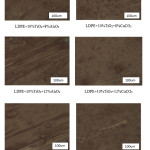K R Dinesh1 and Gururaj Hatti2*
1Department of Mechanical Engineering, Government Engineering College, Raichur, Karnataka., Visvesvaraya Technological University, Belagavi, Karnataka.
2Department of Mechanical Engineering, KLS VDIT, Haliyal, Karnataka. Visvesvaraya Technological University, Belagavi, Karnataka. ORCID-0000-0003-1712-4264
Corresponding Author Email: hatti.gururaj@gmail.com
DOI : http://dx.doi.org/10.13005/msri/150208
Article Publishing History
Article Received on : 06-06-2018
Article Accepted on : 11-07-2018
Article Published : 18 Jul 2018
Plagiarism Check: Yes
Article Metrics
ABSTRACT:
Due to their cost effectiveness, greater strength and ease of fabrication, polymer composites are noticeable candidate almost in all areas. However, when they are used in their original form they possess very low wear resistance and hardness. The present investigation gives information on mechanical properties of polymer matrix composites where LDPE (Low density polyethylene) is used as polymer matrix and TiO2, Al2O3 and CaCO3 are used as reinforcements. The samples were prepared according to ASTM standards by injection moulding machine with varying percentage of reinforcements in polymer matrix. Tests viz., tensile, flexural impact are carried out.
KEYWORDS:
Al2O3, CaCO3; Extruder; Injection moulding; LDPE, TiO2
Copy the following to cite this article:
Dinesh K. R, Hatti G. A Study of the Effect of Tio2, Caco3 and Al2O3 On Mechanical Properties of LDPE Polymer Composites Fabricated by Injection Moulding Technique. Mat.Sci.Res.India;15(2)
|
Copy the following to cite this URL:
Dinesh K. R, Hatti G. A Study of the Effect of Tio2, Caco3 and Al2O3 On Mechanical Properties of LDPE Polymer Composites Fabricated by Injection Moulding Technique. Mat.Sci.Res.India;15(2). Available from: http://jms.envirojms.com?p=512/
|
Introduction
Polymer composites over the decades had more attentions because of their major improvement in mechanical properties. By additions compounds such as Aluminium Oxides (Al2O3),4 glass fibers,5 carbon nanotubes and carbon black,6 to polymers is going to produce new polymer composites with enhanced mechanical and wear resistance properties in addition to being comparatively cost-effective compared to their original corresponding item. This may result in new industrial uses. These reinforcements are going to effect the properties, surface characteristics and bonding of polymer will leads to enriched properties for industries uses [7]. These additives will help to withstand some of the applied tension to the polymer matrix leading to improved tensile properties of the finished product.
Polyethylenes are polymer materials which are easily manufactured and low cost which can be handled at temperature of 140-249 oC.1 Polyethylenes are of three types, in that low density polyethylene (LDPE) one of the type, it as branch structure and property of cross linking. Cross interconnecting nature of polyethylene forms a linkage of high molecular weight, which increases impact strength, ecological stress, flaw and scratch resistance without affecting rigid strength and density to any considerable amount.1
In recent days researchers are using alumina, TiO2 has a reinforcements to enhance the wear properties of LDPE because alumina is hard material and it is unchanged at very high temperature and it exits in two form ionic bonding and covalent bonding.2
To come up with new reinforcement researchers are using calcium carbonate (CaCO3) which has been used as a cheap substitute to the Al2O3 for the production of flexible polyurethane composites to enhance mechanical properties of the finished product. Addition of CaCO3 in thermoplastic fabrication is a common practice for reduced production cost in plastic industry.3
The present work is analysis of CaCO3, Al2O3 & TiO2 reinforced LDPE composite, which are moulded into the shape of the die prepared according to ASTM standard using injection moulding machine on a low budget, which can be functioned with a smaller amount of effort. The prepared specimens are tested for various mechanical properties.
Materials and Methods
There are three type of polyethylenes are available. In which UHMWPE is one which have poor properties like ductility and fracture toughness. But other two polyethylene, LDPE & HDPE have good cross linking property which results in their improved molecular structures and mechanical properties. Both LDPE & HDPE have the similar properties. Therefore, in this investigation low density polyethylene (LDPE) used as polymer matrix material. LDPE have poor mechanical properties and which can be enriched by adding metallic or/and ceramic in the polymer matrix. Hence, in the present study alumina (Al2O3), calcium carbonate (CaCO3) and titanium oxide (TiO2) were used as the reinforcing materials and all the reinforcing materials are in powder form with 325 mesh size. For the perfect results different compositions used for the fabrication of the samples. Based on the literature survey weight percentage of LDPE, Al2O3 and TiO2 for one composition and weight percentage of LDPE, CaCO3 and TiO2 for other composition decided.1,3 Table 1 shows the polymer and reinforcements percentage in production of polymer matrix composites. Figure 2 indicates the specimens produced by injection moulding machine.
Table 1: Compositions of Polymer matrix composites
|
Sr. No.
|
LDPE (%)
|
TiO2 (%)
|
Al2O3 (%)/CaCO3 (%)
|
|
1
|
82
|
10
|
8
|
|
2
|
78
|
10
|
12
|
|
3
|
74
|
10
|
16
|
Test samples were prepared according to ASTM standard. ASTM D638 standards for tensile investigation, ASTM D790 standard for flexural investigation and ASTM D256 for impact investigation specimens. Figures 1a, 1b, and 1c indicate the dimensions of the specimens.1
Figure 1a,1b & 1c: specimen dimensions (mm) for Tensile strength, Impact strength and Flexural strength test
Figure 2: Prepared specimens according to ASTM standard for testing purpose
Extruder is used for composition preparation and Injection moulding machine is used for specimen’s preparation according to ASTM standard. For composition (LDPE, TiO2 & Al2O3) preparation with variation in LDPE, Al2O3 and TiO2 remains constant in all specimens. LDPE which is in granular form and TiO2 & Al2O3 which are in powder form are mixed with measured amount and transferred into hopper of the extruder. The material is slowly melted by the mechanical energy generated by turning screws and by heaters arranged along the screws. The molten polymer composition then passes through die, which give shape to the polymer composite and hardens during cooling. Obtained composites is made into small pieces using pelletizer and transfer all pieces into hopper. Composition pieces are fed by ram from a hopper into a heated barrel. As the granules are slowly moved forward by a screw-type plunger, the pieces are moved into a heated chamber (150-250 oC), were they get melted. As the plunger advances, the melted pieces are forced through a nozzle into the mould where it takes the shape of mould cavity as defined by ASTM standard.8,10 It saves the time and composite material. The same steps are followed to prepare (LDPE, TiO2 & CaCO3) composition. Figure 3 show the Extruder and Figure 4 shows injection moulding machine with mould cavity.
Figure 3: Extruder
Figure 4: injection moulding machine with mould cavity
Tensile, Flexural and Impact test were performed in the KONKAN SPECIALITY POLYPRODUCTS PRIVATE LIMITED testing laboratory, Mangalore, Karnataka. Tensile testing machine make had LOADCELL 20 kN and Test speed 5 mm/min. Flexural testing machine make had LOADCELL 20kN and Test speed 14.93 mm/min. Impact test machine make HIT50P with Nominal work capacity: 7.5 J Theoretical impact velocity: 3.807 m/s.
Results and Discussions
This investigation illustrates the mechanical behavior of LDPE + Alumina/Calcium carbonate + Titanium Dioxide polymer composites. The injection moulding machine was used for fabricating samples and ASTM standards were followed to carry out the test. Table 2 indicates the designation of each composite which will be used throughout this paper.
Table 2: Designations and detailed compositions of the composites
|
Composition
|
Designation
|
|
LDPE+10%TiO2+8%Al2O3
|
A
|
|
LDPE+10%TiO2+12%Al2O3
|
B
|
|
LDPE+10%TiO2+16%Al2O3
|
C
|
|
LDPE+10%TiO2+8%CaCO3
|
A’
|
|
LDPE+10%TiO2+12%CaCO3
|
B’
|
|
LDPE+10%TiO2+16%CaCO3
|
C’
|
Tensile strength: Tensile strength for the prepared polymer composites was carried out and results are represented in bar chart as shown in figure 4. In one composition alumina (Al2O3) is varied from 8% -16% with increase of 4% in a step and TiO2 remains constant of 10% and in other composition calcium carbonate(CaCO3) is varied from 8%-16% with increase of 4% in a step and TiO2 remains constant of 10%. Figure 4 shows that tensile strength increases with the increase in the amount of alumina because of its hard and stiff nature. Hence capacity of the composite increases to carry load.12MPa of C composite shows the greater value among other two composites. In case of (LDPE+TiO2+CaCO3) composition tensile strength increases with the increase in the amount of calcium carbonate due to its hard nature1 and values are represented in bar graph as shown in figure 5. when compared two compositions i.e. one with Al2O3 and other with CaCO3, Composition with C’ shows 12.5Mpa which is greater than alumina composite.
Figure 5: Tensile strength of composites having different percentage of reinforcing material
Flexural strength: Flexural strength for the prepared composites was conducted and values are represented in the bar chart as shown in figure 6. In one composition alumina (Al2O3) is varied from 8% -16% with increase of 4% in a step and TiO2 remains constant of 10% and in other composition calcium carbonate(CaCO3) is varied from 8%-16% with increase of 4% in each step and TiO2 remain constant of 10%. Flexural property increases with the increase in the amount of alumina, which offers resistance to deformation because of its hard and stiff nature.1,2 Hence flexural property increases. 12.9MPa of C composite shows the greater value among other two composites. In case of (LDPE+TiO2+CaCO3) composition flexural property increases with the increase in the amount of calcium carbonate due to its hard nature and values are represented in bar graph as shown in figure 5 The maximum Value obtained was 11.95 MPa for C’.
Figure 6: Flexural strength of composites having different percentage of reinforcing material
Impact strength: Impact strength is the capability of the material to withstand a suddenly applied load and it is calculated by noticing the energy observed, for approximating the impact strength. Impact strength of composites (LDPE+Al2O3+TiO2) are shown in figure 7. Impact strength decreases with increase in amount of alumina in composites this is due to reduction in ductility because of hard and stiff nature of alumina. 52.64kJ/m2 for C shows greater value of impact strength among other two composites which contains alumina. In case of Calcium carbonate impact strength initially increases and decreases as increase in calcium carbonate in composition due its hard and stiff nature. The maximum impact strength obtained was 77.41kJ/m2 for C’.
Figure 7: Impact strength of composites having different percentage of reinforcing material
Microstructure Analysis: All the composites are observed under the optical microscope for mixing of alumina and calcium carbonate in polymer matrix. Figure 8 shows the images of composites under 20X magnification. From images it is clear that particles are spread evenly in the polymer matrix and there are surface imperfections are seen. These surface imperfections are due to mould defects. Enhanced mechanical properties are achieved due to evenly spread and bonding between added particles and polymer matrix.
Figure 8: Optical microscope images of Composites
Conclusion
Present investigation has been made to produce a polymer matrix composites for industrial and technological applications. Based on the results, conclusions are drawn.
- Tensile and flexural strength increases with increase in the amount of alumina and Calcium carbonate in the polymer matrix composite.
- Due to increase in the ductility as there is an increase in amount of alumina and calcium carbonate in composites, impact strength decreases.
- Optical microscopy images show some surface imperfections in produced specimens. By results, an evenly spread of particles and bonding between added particles and polymer matrix is seen.
Defects free specimens can be prepared using injection moulding machine.
Acknowledgements
The corresponding author expresses his thanks to Dr. K R Dinesh for his valuable suggestions. The corresponding author also wishes to extend his sincere thanks to HOD, PST department, SJCE, Mysuru, Karnataka for giving us permission to prepare specimens.
Funding Source
The author declares that the funding is done by corresponding author only.
Conflict of Interest
The author(s) declare(s) that there is no conflict of interests regarding the publication of this article.
References
- Dhabale R and Jatti V. S. A bio-material: mechanical behaviour of LDPE-Al2O3-TiO2” IOP Conf. Series Materials Science and Engineering. 2016;149.
CrossRef
- Gulia V., Rahul B. D., Dr.Vijaykumar S. J. Evaluation of mechanical properties of Polyamide-Alumina-Titanium Dioxide for biomedical application. International conference on Advances in Thermal Systems, Materials and Design Engineering. ATSMDE. 2017.
- Prabhu R., Mendonca S., Gladson D. Thirumaleshwara Bhat Mechanical and Tribological Properties of Injection Moulded Modified CaCO3/PP, LDPE Composites. American Journal of Materials Science. 2016;61-66.
- Pool K. V., Dharan C. K. H., Finnie I. Erosive wear of composite materials. Wear. 1986;107:1-12.
CrossRef
- Kaynak C., Arikan A., Tincer T. Flexibility improvement of short glass fiber reinforced epoxy by using a liquid elastomer. Polymer. 2003;44::2433–2439.
CrossRef
- Chen Z. K., Yang J. P., Ni Q. Q., Fu S. Y., Huang Y. G. Reinforcement of epoxy resins with multi-walled carbon nanotubes for enhancing cryogenic mechanical properties. Polymer. 2009;50:4753–4759.
CrossRef
- Zhou S. S., Wu L. M., Sun J., Shen W. The change of the properties of acrylic –based polyurethane via addition of nano-silica. Progress in Organic Coatings. 2002;45:33-42.
CrossRef
- Maria R. F.,Carcea I. Polymer Matrix Composites – Routes And Properties. International Journal of Modern Manufacturing Technologies. 2012.
- Zameer a. S., Haneef M. Mechanical and Tribological Behavior of Bio Polymer Matrix Composites for Biomedical Prosthesis Applications. Advanced Materials Research. 2015;7-12.
- Vardhan N. A. R., Prof. T. J. mechanical properties of uhmwpe-carbon nano tube composite for total hip prostheses. International journal of engineering sciences & research technology. 2017:295-303.

This work is licensed under a Creative Commons Attribution 4.0 International License.
 Material Science Research India An International Peer Reviewed Research Journal
Material Science Research India An International Peer Reviewed Research Journal

